
监利近800岁重阳木 用年轮刻录历史烟云
A Nearly 800-Year-old Chinese Bishopwood Tree in Jianli Chronicles the Local History with its Annual Rings
极目新闻记者 黄志刚
翻译:梅昌瑞、许娜、宋婷 (湖北大学)
Jimu News Reporter: Huang Zhigang
Translators: Mei Changrui, Xu Na, Song Ting (Hubei University)
“打起来/闹起来/大家打起精神来/自从盘古开天地/一首田歌唱到今/轻轻打起龙凤鼓/慢慢逍遥把歌轮……”
"Get up/ Be joyful/ Everyone, cheer up/ Since Pan Gu separated the Earth and the Sky/ A field song has been sung till now/ Beat the dragon and phoenix drums gently/ Sing songs slowly and freely……"
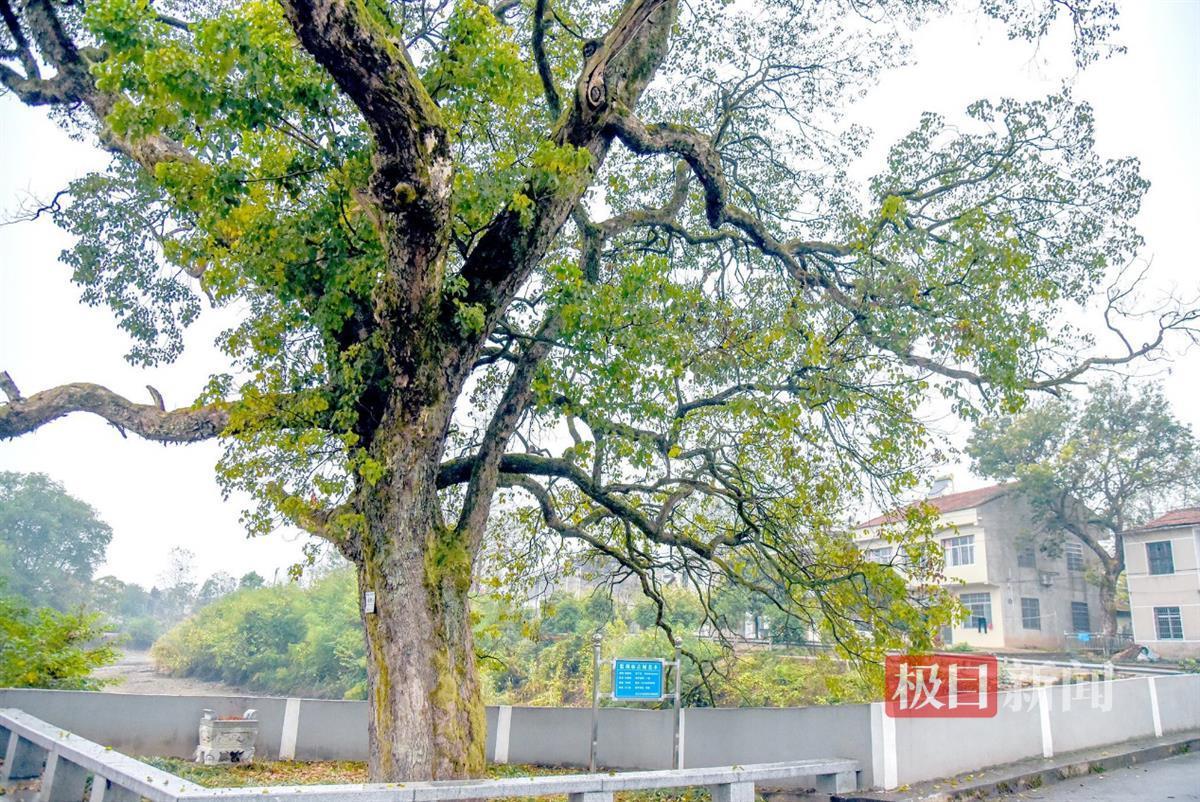 两棵雌雄重阳木古树分列河畔两岸(极目新闻记者黄志刚摄)A female and a male Chinese bishopwood tree stand on the opposite banks of the river respectively.(Photographer: Jimu News Reporter Huang Zhigang)
两棵雌雄重阳木古树分列河畔两岸(极目新闻记者黄志刚摄)A female and a male Chinese bishopwood tree stand on the opposite banks of the river respectively.(Photographer: Jimu News Reporter Huang Zhigang)
冬日时节,荆州市监利市柘木乡赖桥村,午后暖阳洒向近800岁的重阳木树枝,古树下,赖晓平正带领7名村妇演唱秧歌号子《啰啰咚》选段。高亢婉转的劳动号子,在柘木长河两岸传开。听闻歌声,赖桥村的老少爷们纷纷围拢在老树下,不禁驻足喝彩。
Nestled in Laiqiao village, Zhemu town, Jianli county-level city, Jingzhou city, the nearly 800-year-old Chinese bishopwood tree, known in Chinese as "Chung Yeung Wood", whose scientific name is bischofia polycarpa (H.Lév.) airy shaw, is bathed in warm afternoon sunlight in the wintertime. Under the tree, Lai Xiaoping is leading seven village women in singing an excerpt from Luoluodong, a section of yangko haozi, a well-known rural folk dance and work song. The high-pitched and melodious work song transcends to both sides of the Zhemu River, and upon hearing it, the young and old of Laiqiao village gather under the ancient tree, and cannot help but stop to enjoy and applaud.
历经岁月更迭,生机勃勃的重阳木依旧与古老的《啰啰咚》曲调相依相伴,共同见证柘木人劳动耕作的场景,刻录着乡村的历史烟云,唱响着美丽蜕变的乡村未来。
Throughout years, the vibrant Chinese bishopwood trees have been and continue to be accompanied by the traditional Luoluodong tune, witnessing together the scenes of Zhemu people at work and the local history while singing about the future of the beautifully transformed countryside.
 村民在重阳木古树下载歌载舞(受访者供图)Villagers sing and dance under the ancient tree (Photo provided by interviewee)
村民在重阳木古树下载歌载舞(受访者供图)Villagers sing and dance under the ancient tree (Photo provided by interviewee)
雌雄重阳古木分列河畔两岸
The Male and the Female Chinese Bishopwood Tree Standing on the 2 Banks
柘木乡,一个因盛产柘木得名的古老乡镇。它地处洞庭湖、洪湖、长江组成的三角洲中心,为古云梦泽腹地。柘木长河贯穿水乡古镇,因河上的桥梁均用柘木建造,故称“柘木桥”。
Zhemu Town is an ancient town, named after its abundance of Zhemu wood (scientific name: maclura tricuspidata). It is located in the center of the delta consisting of Dongting Lake, Honghu Lake and Yangtze River, the hinterland of Yunmengze (an ancient geographic concept). The Zhemu River runs through the ancient waterside towns, and the bridge over the river was formerly called "Zhemu Bridge" as it was entirely constructed of Zhemu wood.
时光荏苒,尽管柘木桥早已不见踪迹,但柘木长河的潺潺流水依然日夜不息。在柘木乡赖桥村的柘木长河两岸,两棵重阳木古树屹立不倒,其中一棵树龄达到790年。
Time has passed. Although the Zhemu bridge has long since disappeared, the gurgling water of the Zhemu River continues to run day and night. On the banks of the Zhemu River, Laiqiao Village, Zhemu Town, two ancient trees stand, one of which is 790 years old.
近日,极目新闻记者来到赖桥村,探访这棵饱经沧桑的古树。站在重阳木树下,尽管是隆冬,但古树依然枝繁叶茂。
A Jimu News reporter recently visited the ancient trees in Laiqiao Village. Even in the depths of winter, standing beneath the trees, one could see that the ancient trees were still flourishing with strong branches and lush green leaves.
“小时候就这么大,老树基本没怎么长了。”今年60岁的赖晓平从小就在重阳木古树下玩耍,他对极目新闻记者说,眼前这棵刻录赖桥村历史烟云的古树充满无尽的历史故事。
"The ancient trees have not grown much and are just as big as I remember seeing them as a child. " 60-Year-old Lai Xiaoping, told the reporter that the ancient trees in front of them, under which he played around frequently as a child, has countless historical tales of Laiqiao Village etched in its annual rings.
2020年,柘木乡组织工作专班进行摸排调查,共发现现存百年以上古树50棵,主要有柘木、重阳、棠梨、枸骨等树种。其中,200年以上树龄的古树6棵,500年至800年树龄的古树2棵,即分列于柘木长河两岸的重阳木。
In 2020, the local government of Zhemu town organized researching and investigation teams, and found a total of 50 ancient trees of more than 100 years, mainly including Zhemu wood, Chinese bishopwood, birchleaf pear (scientific name: Pyrus betulifolia Bunge, also known as tang li in Chinese), and Chinese holly (scientific name: ilex cornuta). Among them were 6 ancient trees over 200 years old, 2 ancient trees of 500 and 800 years, namely, the Chinese bishopwood trees growing on both sides of the Zhemu River.
在赖桥村,不少人将河两岸的两棵雌雄重阳木称之为“夫妻树”,但查阅古树的“身份证”信息得知,雌性重阳木,编号为42102300003,树龄为790年,树高19.5米;雄性重阳木,编号为42102300025,树龄为500年,树高15.8米,两棵重阳木树龄相差290岁。因此,将它们称之为“母子树”似乎更贴切。
In Laiqiao village, many people call the male and female trees on the banks of the river the "couple trees". But further investigation on their "real identities" reveals that the female tree, No. 42102300003, is 790 years old, and 19.5 meters tall, while the male one, No. 42102300025, is 500 years old and 15.8 meters tall, creating an age gap of 290 years. Therefore, it seems more appropriate to call them "mother and son".
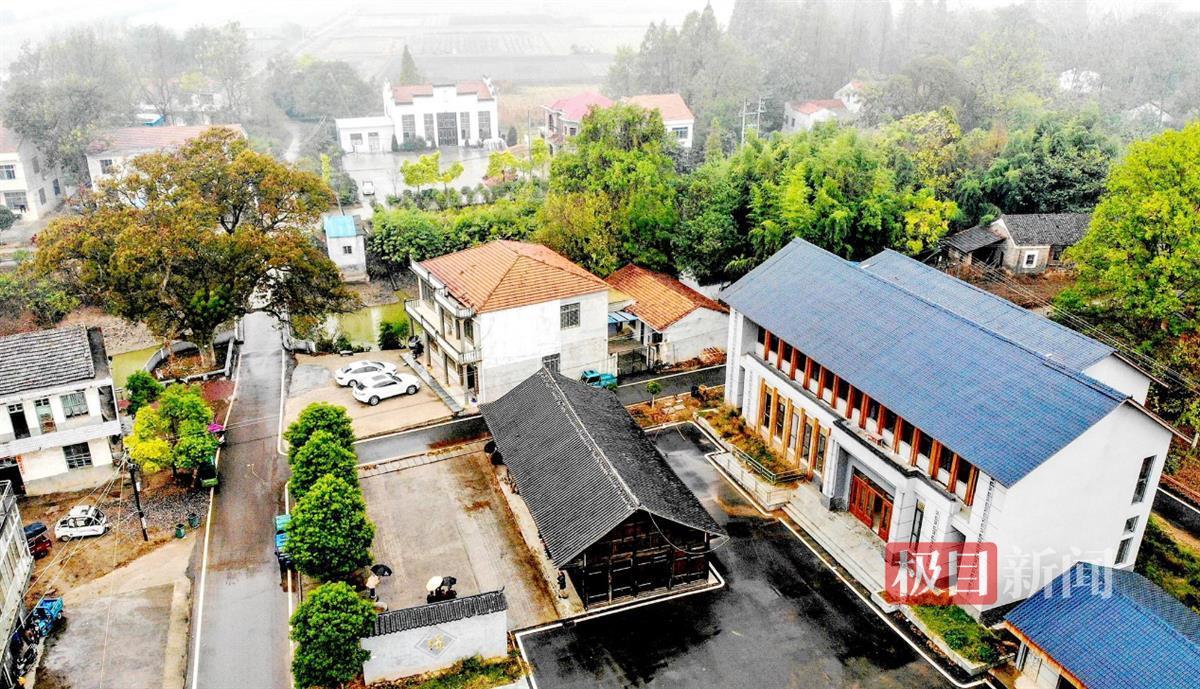 赖晓平的农家博物馆紧邻重阳木古树Lai Xiaoping's private museum in the rural area next to the ancient tree
赖晓平的农家博物馆紧邻重阳木古树Lai Xiaoping's private museum in the rural area next to the ancient tree
赖晓平家门口那棵最大的重阳木是雌树,树干粗3.87米,直径1.27米,“需要3个成人才能合抱围一圈。”
The largest one in front of Lai Xiaoping's home is a female tree with a trunk circumference of 3.87 meters and a diameter of 1.27 meters. "It takes three adults to embrace it as a close loop," he said.
据悉,重阳木是水陆两栖树种,素有“千年柘木,万年重阳”的说法。1985年,在赖桥村河床下6米处,发现了大量重阳树阴沉木。当时还在离重阳木5米远的河边,挖出了两个巨大的重阳树树蔸。
It is reported that the Chinese bishopwood is an amphibious treewhich is alluded in the common saying "Zhemu wood can live for a thousand years, while the Chinese bishopwood can for ten thousand years". In 1985, thousands of years' worth of carbonized yinchen Chinese bishopwood, was found buried 6 meters below the riverbed here. At that time, two huge stumps (known as shudou in the local dialect) of Chinese bishopwood were also excavated by the river, 5 meters away from it.
1998年大暴雨后,在古树根下出现了几枚宋代钱币、一对小陶俑,以及大量元明时期的陶瓷残片,还有一块明朝万历十年的刻字碑石,碑石上清晰地刻着“容邑沙城里侯家桥”等字。
After a heavy rainfall in 1998, under the roots of the ancient tree appeared several coins, a pair of small ceramic figurines of the Song Dynasty, a large number of ceramic fragments from the Yuan and Ming Dynasties, and an inscribed tablet from the 10th year of Wanli period in the Ming Dynasty, with the legible writing "rong yi sha cheng li hou jia qiao (Houjia bridge in Shacheng li (ancient administrative level), Rongyi county)".
湖北省林业专家曾说,柘木长河两岸是一个密度较高的乡土古树群落带,在江汉平原十分罕见,对研究江汉平原与云梦古泽湿地生态环境有极大帮助。
Forestry experts in Hubei Province have said that the banks of the Zhemu River are a zone with a high concentration of native ancient tree communities, which is very rare in the Jianghan Plain and is extremely helpful for researching the ecology of the Jianghan Plain and the ancient Yunmengze wetlands.
目前,柘木乡正大力抢救和保护当地的“绿色文物”,经过走访、摸查,掌握全乡古树名木的一手资料,并将第一批申报的24棵省级古树张贴二维码,办理古树“身份证”。
At present, Zhemu town is vigorously rescuing and protecting the local "green heritage". By gathering first-hand information of the town's ancient and valuable trees through site visits and investigations, the first batch of 24 provincially certified ancient trees have had their QR codes posted, serving as their "ID cards".
古树年轮刻录辛弃疾征战历史
The History of Xin Qiji's Campaign Inscribed on Annual Rings
“赖姓是赖桥村的大姓。”赖晓平说,在合村并组前,赖姓村民占全村人口数量的90%,“根据族谱记载,赖桥村一带的赖姓多为南宋末年茶贩起义领袖赖文政的后裔。”
"Lai accounts for the majority of surnames in Laiqiao village." Lai Xiaoping said that before the villages and groups were merged, the Lais accounted for 90% of the village's population. "According to genealogical records, in the area of Laiqiao village, residents surnamed Lai are mostly descendants of Lai Wenzheng, the leader of the tea-seller uprising in the late Southern Song Dynasty."
宋代的茶叶和盐一样,都是政府专卖品。史料记载,南宋末年,朝廷加重赣、湘、鄂等地茶贩、茶农的茶叶赋税,引发茶贩、茶农与朝廷对抗。
Tea, like salt, was monopolized by the government during the Song Dynasty. According to historical records, at the end of the Southern Song Dynasty, the Imperial Court increased taxes on tea purchased from tea sellers and farmers in Jiangxi, Hunan, and Hubei, triggering a confrontation between tea sellers and farmers and the Imperial Court.
生计无着之下,茶商自发组织了武装,强行贩卖茶叶,遇到朝廷关卡就武力硬闯。茶贩出身的赖文政,于宋乾道九年(公元1173年)在湖南参加茶贩起义。两年后,他在湖北被推为起义首领,率众数百人进入潭州(今湖南长沙),并在鄂湘赣粤四地来回移动,依靠有利地形,多次以少胜多打败朝廷军队,茶商军的声势越来越大。
Faced with no visible means of subsistence, tea merchants voluntarily organized armed groups to smuggle tea and break through when encountered with an imperial checkpoint. Lai Wenzheng, as a tea seller, participated in the uprise in Hunan in the 9th year of Qiandao (A.D. 1173) of the Song Dynasty. Two years later, he was promoted as the leader of an uprising in Hubei Province. He led hundreds of volunteers into Tanzhou (today's Changsha in Hunan Province) and fought in Hubei, Hunan, Jiangxi and Guangdong. Relying on the favorable terrain, he defeated the great imperial army by a small number of risers. The tea troop was becoming stronger.
此时,朝廷之上,雷霆震怒,群臣无策。1175年,在主战派的宰相叶衡举荐下,宋孝宗命时年36岁的辛弃疾为江南西路提点刑狱公事,负责“节制诸军,讨捕茶寇”。
The emperor was furious and his ministers had no solution. In 1175, Emperor Xiaozong of Song Dynasty, under the recommendation of Ye Heng, the prime minister of the pro-war faction, appointed Xin Qiji, 36 years old at the time, as the Tidianxingyuguan (criminal prison officer) of Jiangnanxi Lu (an administrative level). His primary responsibilities included "controlling the armies and arresting the tea rebels".
军人作风的辛弃疾,走马上任后招募敢死队,结合熟悉江南地形的乡兵,以虚虚实实的疲敌战术和紧追不舍的武力压力,率军步步为营,围追堵截。
After taking office, army-man Xin Qiji recruited dare-to-die squads. Together with township soldiers who were familiar with Jiangnan terrain, they encircled and intercepted the enemies using a combination of military tactics and increasing pressure by closely pursuing their enemies to tire them.
后来,赖文政率领的茶商军身心疲惫不堪,茶商军进入广东受挫后又返江西兴国,被辛弃疾招降。临危受命的辛弃疾,利用约三个月时间就平定了茶商军,一战成名的他,开始受到宋孝宗重用。
Later, the tea-merchant troop led by Lai Wenzheng became physically and mentally exhausted, and after their defeat in Guangdong province eventually surrendered to Xin Qiji in Xingguo county in Jiangxi. In about three months, Xin Qiji defeated the tea troop. This battle brought him great fame and elevated him to high positions at the appointment of Emperor Xiaozong.
历史有两种说法,一种是赖文政招降后被杀于江洲(今九江),一种说法是赖文政后逃脱,并来到今湖北监利一带隐居,其后裔先后辗转如今的柘木乡一带安顿。
There are two versions of this story. One is that Lai Wenzheng was killed in Jiangzhou (today's Jiujiang) after surrendering; the other is that Lai Wenzheng escaped and hid in the area of Jianli, Hubei, and his descendants successively settled in the area of Zhemu Town.
不过,按照时间推算,赖桥村现存这棵790年树龄的雌性重阳木,与南宋时期辛弃疾征讨镇压赖文政茶商军的历史时期相当。
However, according to its age of 790 years, the female Chinese bischopwood in Laiqiao village coincides with the historical period when Xin Qiji conquered Lai Wenzheng's tea troop in the Southern Song Dynasty.
“历史的烟云仿佛刻进古树的年轮,传承至今。”赖晓平说,这棵790岁的重阳木已成为监利最古老的一级保护古树名木,而他也自发成为古树的守护者。
"History seems to be carved into the rings of ancient trees and passed down to the present." Lai Xiaoping said that the 790-year-old Chinese bischopwood has become the oldest famous tree under first class protection in Jianli, and he has voluntarily become its guardian.
古树之下重新响起啰啰咚
Luoluodong Sung Again Under the Old Tree
赖晓平的本业是赖桥村的乡村医生,但这位村民口中的“赖医生”却因挖掘、整理和传播监利原生态秧歌号子“啰啰咚”,而被众人知晓。
Lai Xiaoping's originally worked as a doctor in Laiqiao village, but now "Doctor Lai" is known for searching for, sorting out and spreading the pristine yangko "Luoluodong" in Jianli.
监利是江汉平原的农业重镇,境内良田万顷无垠。其中,秧田作业是水稻生产的重要过程,劳动强度大,季节性强。
Jianli is an important agricultural town in Jianghan plain with boundless fertile fields. Rice transplanting is an important process of rice production, and is also a laborious and highly seasonal agricultural activity.
为了不误农时,农民往往要相互邀集,群体劳作。为了调剂人们的精神,消除疲劳,统一劳动节奏,产生了适合这一生产劳动的歌曲,这些劳动号子便成了“啰啰咚”最原始、最根本的基础和雏形。
Farmers often collaborated by working in groups to avoid missing the farming season. Songs suitable for this type of work were created to lift people's spirits, eliminate fatigue, and synchronize the rhythm of their workflow. These work songs later became the primitive prototype of Luoluodong.
“啰啰咚”的发音是监利南部地区的方言,主要以演唱民间唱本为主,内容朴实无华、生活气息浓郁,表现的是农民朴野而又乐天的性格,描绘出具有地域特征的民风乡俗,透着天然神韵的本色,成为平原地区“具有山歌特点的原生态地方民歌”。
Utilizing the pronunciations from a dialect in the southern region of Jianli, "Luoluodong"is primarily composed of folk songs with simple content and a rich flavor of life, depicting the farmers' simplicity and optimism, describing folk customs with regional characteristics, and revealing the natural charm. These songs have thus become the "pristine local songs with the characteristics of folk songs" in the plain area.
“啰啰咚”演唱场景通常在水田,它采用男女接力式的传声唱法,曲式结构具有复调音乐的特色和“无伴奏自然和声”的特点,俗称“打和声”。
"Luoluodong" is mainly sung in paddy fields. It adopts the relay singing method of men and women. Its musical structure is characterized by polyphony and "unaccompanied natural harmony", commonly known as "dahesheng" in the dialect.
因痴迷乡土文化,数十年来,赖晓平以守护民间文化为己任,经他挖掘整理的“啰啰咚”已成功申报为国家级“非遗”项目。
Due to his fascination with the local culture, Lai Xiaoping has taken the duty of protecting folk culture upon himself for decades. The "Luoluodong" discovered and organized by him has been successfully declared as a national "intangible cultural heritage" project.
每年插秧季节,只要一有空,赖晓平就到田里帮乡亲们插秧,他边听边学边记,晚上还到村里找人唱插秧号子。
During every planting season, as long as Lai Xiaoping is available, he goes to the field to help the villagers in transplanting rice, listening to and learning yangko while they work. In the evening, he also visits the villagers in search of someone willing to sing yangko.
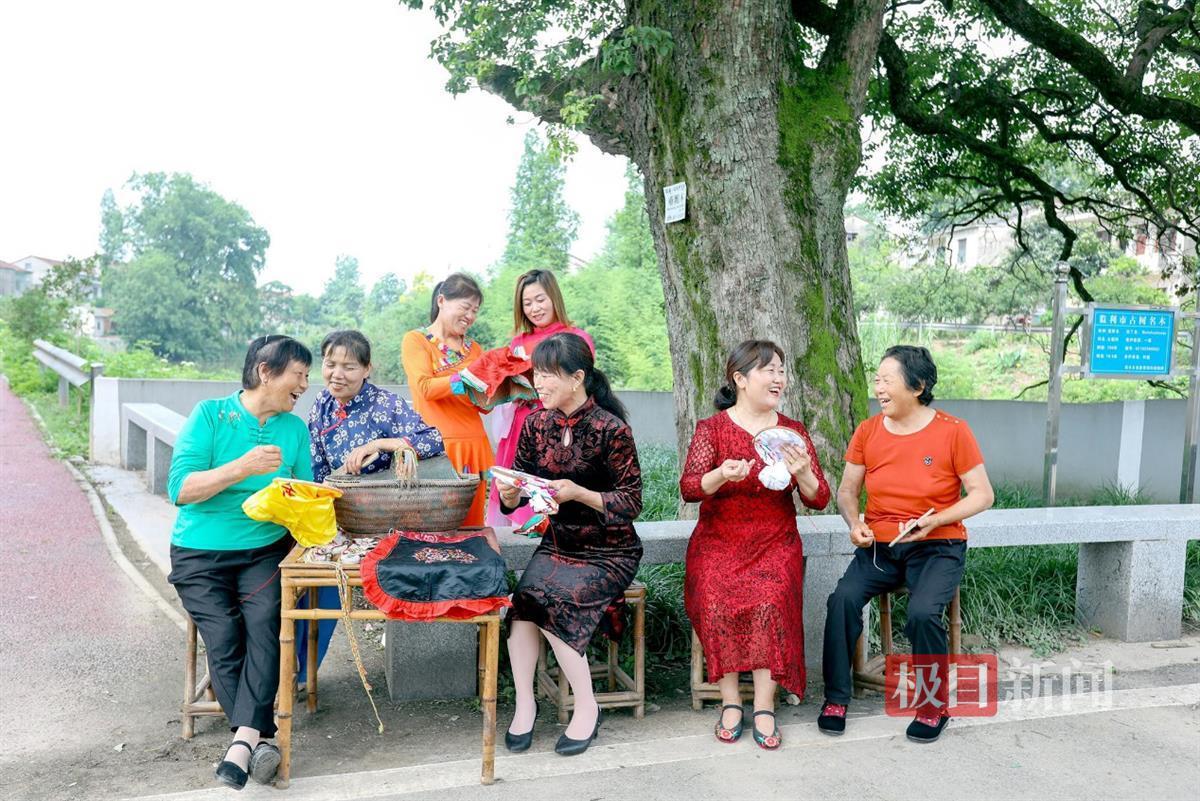 合唱团在重阳木古树下做针线活(受访者供图)The local chorus doing needlework under the ancient tree (Photo provided by interviewee)
合唱团在重阳木古树下做针线活(受访者供图)The local chorus doing needlework under the ancient tree (Photo provided by interviewee)
“他是个不务正业的人。”赖晓平的妻子魏杏元说,当年,两个孩子正在上大学,家里经济负担重,但丈夫赖晓平经常自掏腰包,将村里会唱插秧号子的老人请到家里吃饭,让他们教年轻人演唱“啰啰咚”,“最后把我也发动进来了,成了合唱团的一员。”
"He runs an irrelevant business". Wei Xingyuan (Lai Xiaoping's wife) said that their family was financially burdened at the time since their two children were in college. Her husband, however, often paid out of his own pocket to invite elderly people who could sing yangko to dinner at their home, in exchange for them teaching younger people how to sing "Luoluodong". "In the end, he convinced me to become a member of the chorus."
赖晓平的“不务正业”也遭到了村民的冷嘲热讽,但他并没有放在心上。在持续的收集、整理下,赖桥村的“啰啰咚”合唱团已经有了7名演唱者,年龄最大的陈凡珍老人今年已经78岁。
Lai Xiaoping's "irrelevant business" was mocked by some villagers, but he did not take it to heart. Under his continuous search and arrangement, the "Luoluodong" chorus in Laiqiao village now has seven singers, with Mr. Chen Fanzhen who is 78 years old this year, being its oldest member.
顶着经济压力,赖晓平还多次出资举办“啰啰咚”演唱会。重阳木古树下,原汁原味的秧歌号子此起彼落,高亢、悠长的旋律仿佛从历史时光中倾泻而出,诉说着先民的智慧与勤劳。
Despite financial constraints, Xiaoping also funded several "Luoluodong" concerts. Under the ancient tree, the authentic yangko rises and falls, and the high-pitched and long melody seems to pour out of history, recounting the wisdom and diligence of the ancestors.
目前,为了传承“啰啰咚”非遗项目,监利市已经在包括柘木乡在内的周边9个乡镇,挂牌成立“啰啰咚传习所”,培养了一大批“啰啰咚”传承人。
Jianli city has now established the "Luoluodong Training Institute" in 9 surrounding villages and towns including Zhemu village and cultivated a large number of inheritors for the "Luoluodong" intangible cultural heritage project.
重阳古木旁建起乡村博物馆
A Village Museum Built beside the Ancient Chinese Bishopwood
一棵古树,一方水土,一方风情。除了“啰啰咚”之外,与重阳木古树相伴一辈子的赖晓平,正将自家房屋改造成私人博物馆,展示和传承监利的乡土文化。
An ancient tree, the local water and soil have shaped the folk custom. In addition to "Luoluodong", Lai, who has accompanied the ancient tree for a lifetime, is converting his house into a private museum to display and carry forward Jianli's local culture.
监利市境内有大溪文化、石家河文化等新石器时代遗迹,是楚文化的重要发祥地之一。多年来,文物部门多次在监利市白螺镇狮子山及柳关等地发现多处新石器时代文化遗址。
Jianli city, on of the important birthplaces of Chu culture, contains some remains of the Neolithic Age such as Daxi culture and Shijiahe culture. Over the years, the cultural relics department has discovered numerous Neolithic cultural sites in Shizishan of Bailuo Town, Liuguan and other places in Jianli.
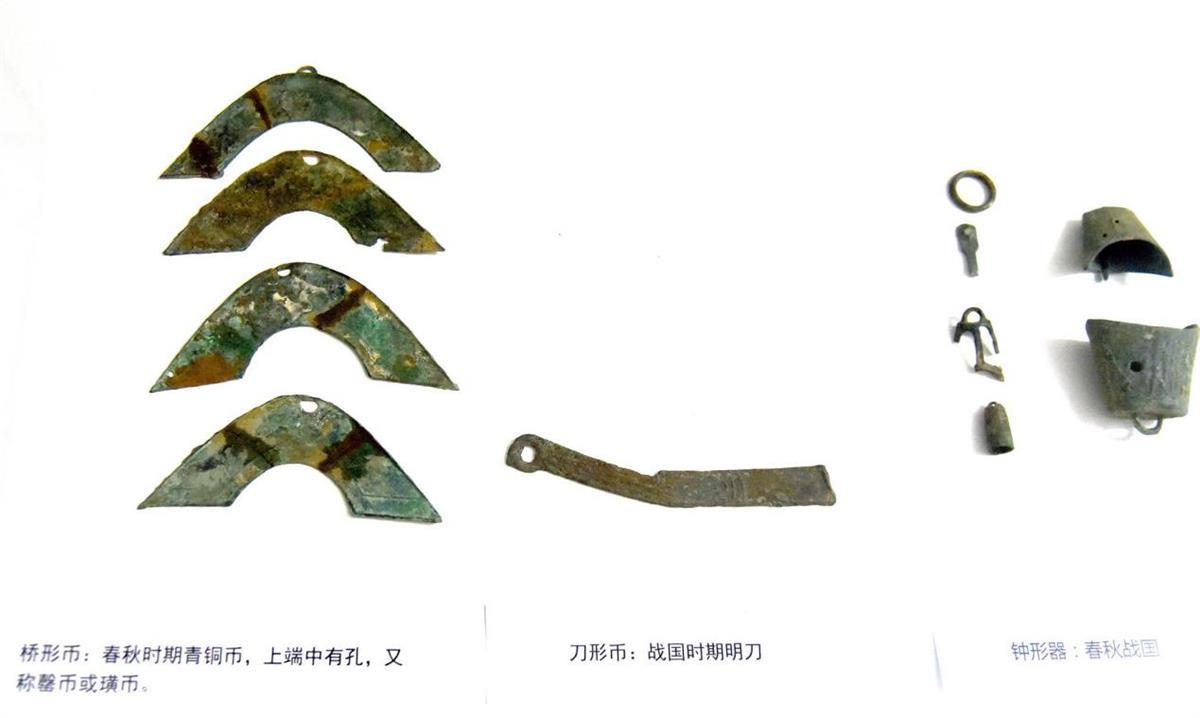 农家博物馆展示的春秋战国时期的青铜币Bronze coins of the Spring and Autumn and Warring States Periods displayed at the museum
农家博物馆展示的春秋战国时期的青铜币Bronze coins of the Spring and Autumn and Warring States Periods displayed at the museum
痴迷民间文化的赖晓平,经过30多年节衣缩食,收集到3000多件地方文化遗存及大量民俗藏品,经多方努力,2022年上半年,赖晓平的农家博物馆正式开放。
Obsessed with folk culture, Lai has collected more than 3,000 local cultural relics and a large number of folk collections after more than 30 years of living frugally. After the efforts of many relevant parties, Lai Xiaoping's village museum was officially opened in the first half of 2022.
极目新闻记者走进博物馆内看到,史前文化、古代文化、近现代文化及民俗文化四个展厅分别由自家房屋一楼的客房和后院偏房改造而成。
The reporter walked into the museum and noticed that the four exhibition halls of prehistoric culture, ancient culture, modern culture and folk culture were rebuilt from the guest rooms on the first floor and side rooms in their own backyard.
监利白螺镇狮子山出土的远古化石,包括三叶虫化石、鹦鹉螺化石等一一陈列。按照时代顺序,从旧石器时代的打制石器、砍砸器、刮削器等,再到新石器时代石器,包括石斧、石锛、石钺、石铲、石刀等一应俱全。
Ancient fossils unearthed from Shizishan, Bailuo town in Jianli, including trilobite fossils and nautilus fossils were displayed. In chronological order, they were fully display from the chipped tools, choppers, and scrapers in the Paleolithic age, and stone axes, stone adzes, stone tomahawks, stone spades, to the stone knives of the Neolithic age.
赖晓平说,出自狮子山的这些石器、陶器,经武汉大学和荆州博物馆的考古专家鉴定,均属典型的新石器时代遗物,为大溪文化遗存。
According to Lai, the stone tools and pottery discovered in Shizishan by archaeological experts from Wuhan University and Jingzhou Museum are typical Neolithic relics and remains of Daxi culture.
“他是一个存不住钱的人。”魏杏元说,30多年来,赖晓平四处收集充满民俗文化的老物件,以至于几乎所有的收入都用在收藏事业,“为了收藏这些‘宝贝’,总共投了30多万元。”
"He's a man who is incapable of saving money". Wei Xingyuan said, for more than 30 years, Lai has collected vintage items from various places full of folk culture, devoting nearly all his income to the collection. "In order to collect these ‘treasures’, he invested more than 300,000 yuan".
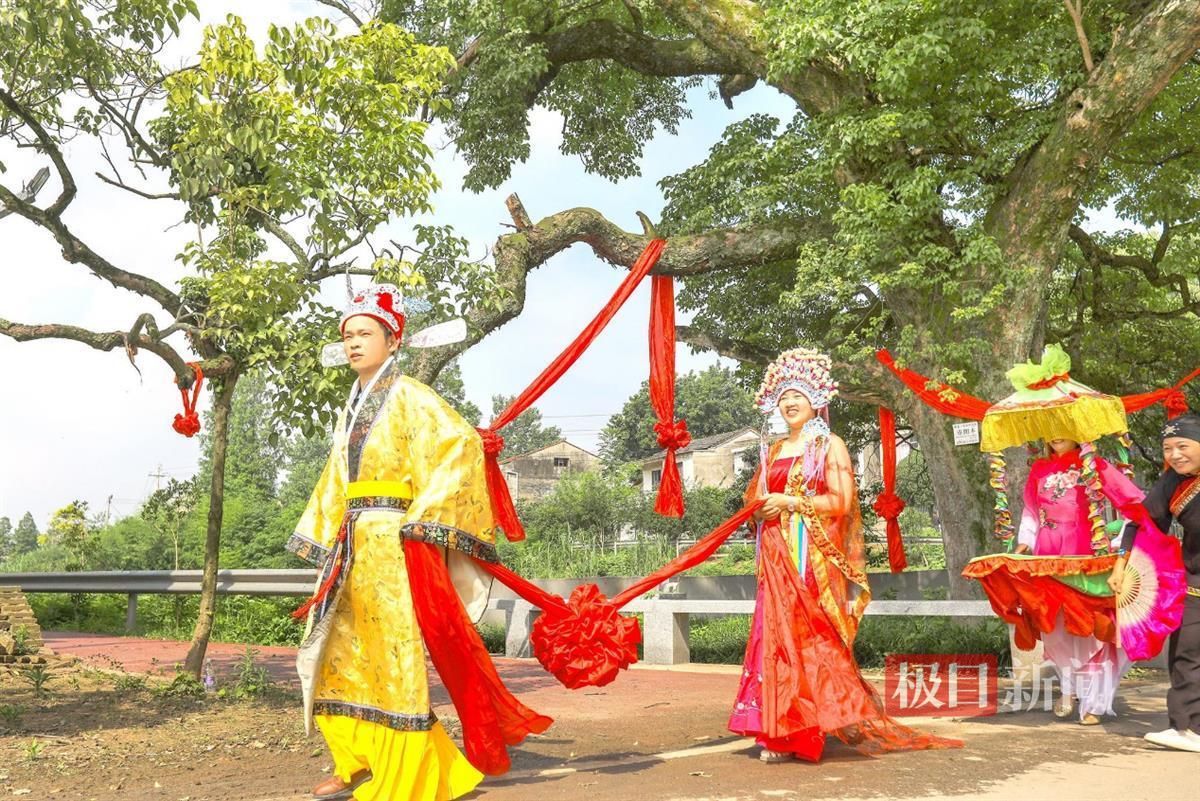 在重阳木古树的见证下举行传统婚礼(受访者供图)The ancient tree witnesses a traditional Chinese wedding ceremony (Photo provided by interviewee)
在重阳木古树的见证下举行传统婚礼(受访者供图)The ancient tree witnesses a traditional Chinese wedding ceremony (Photo provided by interviewee)
在民俗文化展厅,极目新闻记者看到,晚清雕花婚床保存完好,民俗文化特色浓厚,原配的绣花枕头、花铺巾、被套、绣花鞋等一应俱全,为地方古老婚俗留下了珍贵资料。
In the folk culture exhibition hall, the reporter observed that a carved wedding bed from the late Qing Dynasty was well preserved with a strong folk culture characteristic. The original embroidered pillow, drapes, quilt covers, and shoes were still intact, leaving precious materials about the local ancient wedding customs.
“很有时代印记,值得展示的历史。”前来参观的沙市女孩毛沐阳还换上传统服饰,坐在婚床上拍摄“穿越历史”的影像。
"It is a mark of the times and a history worth showing", said Mao Muyang, a girl from Shashi, who was dressed in traditional clothes and sat on the wedding bed to take videos of "time-travel".
而值得一提的是,一套从清朝嘉庆元年到1948年,湖北地方政府向农民征收田地赋税的400多份票据,是赖晓平从事收藏工作30多年的“得意之作”。有文史专家曾评价称:全套票据是湖北近现代财政税收的重要史料。
It's worth mentioning that a set of over 400 farmland taxes bills levied by the the local government of Hubei province from the first year of Jiaqing in Qing Dynasty to 1948, is Lai Xiaoping's "proudest feat" from his 30 years collection. A literature and history expert commented that the full set of bills was an important historical record of Hubei's modern financial tax.
 赖晓平在他的私人博物馆观察藏品Lai Xiaoping observing the collections in his private museum
赖晓平在他的私人博物馆观察藏品Lai Xiaoping observing the collections in his private museum
“让更多的人了解监利的乡土文化。”赖晓平说,开办农家博物馆的初衷,就是为了向公众展示几十年来的收集、收藏成果,展示地方人文历史是他多年夙愿。
"Let more people know about the local culture of Jianli". Lai Xiaoping said, the original aim of opening the rural museum was to show the results of decades of collection efforts and the local history to the public, and it is still his long-cherished wish.
“把浓郁厚重的乡土文化传承下去,让人们记住乡愁。”监利市柘木乡宣传委员赵航说,目前,在实施乡村振兴战略过程中,柘木乡正结合赖桥村的重阳木古树、“啰啰咚”非遗项目,以及农家博物馆等载体,打造乡村旅游线路,助推乡村文化振兴、产业振兴。
"We will pass on the rich and strong local culture and let people relive nostalgic memories", said Zhao Hang, the publicity committee member of Zhemu town, Jianli City. Now, in the process of implementing the rural revitalization strategy, facilitated by the ancient Chinese bishopwood, the intangible cultural heritage project "Luoluodong" and the rural museum, Zhemu town is designing rural tourism routes to boost the revitalization of rural culture and industry.
